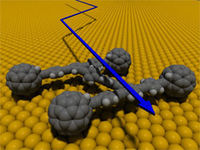What is a Nanocar -- Molecular Machines
Nanocars are basically molecular machines -- the 'worlds smallest machines'
NEW --Stockhom October 5, 2016- Three scientists won the Nobel Prize on Wednesday in Chemsitry for their developing the world's smallest machine. 1000 times smaller than a human hair Jean-Pierre Sauvage, University of Strasbourg, France; Sir J. Fraser Stoddart, Northwestern University, Evanston, IL, USA; Bernard L. Feringa, University of Groningen, the Netherlands --"for the design and synthesis of molecular machines"
"...The first step towards a molecular machine was taken by Jean-Pierre Sauvage in 1983, when he succeeded in linking two ring-shaped molecules together to form a chain, called a catenane. Normally, molecules are joined by strong covalent bonds in which the atoms share electrons, but in the chain they were instead linked by a freer mechanical bond. For a machine to be able to perform a task it must consist of parts that can move relative to each other. The two interlocked rings fulfilled exactly this requirement.
The second step was taken by Fraser Stoddart in 1991, when he developed a rotaxane. He threaded a molecular ring onto a thin molecular axle and demonstrated that the ring was able to move along the axle. Among his developments based on rotaxanes are a molecular lift, a molecular muscle and a molecule-based computer chip.
Bernard Feringa was the first person to develop a molecular motor; in 1999 he got a molecular rotor blade to spin continually in the same direction. Using molecular motors, he has rotated a glass cylinder that is 10,000 times bigger than the motor and also designed a nanocar...." see more from NobelPrize.org
Rice University Research Using Fullerenes
Fuerther research in the nanocar molecule was designed in 2005 at Rice University in the group of Professor James Tour. Despite the name, the nanocar does not contain a molecular motor, hence, it is not really a car. Rather, it was designed to solve the question of how fullerenes move about on metal surfaces; specifically, whether they roll or slide.

The molecule consists of an H-shaped 'chassis' with fullerene groups attached at the four corners to act as wheels.
When dispersed on a gold surface, the molecules attach themselves to the surface via their fullerene groups and are detected via scanning tunneling microscopy. One can deduce their orientation as the frame is a little shorter than its width.
Upon heating the surface to 200 °C the molecules move forward and back as they roll on their fullerene "wheels". The nanocar is able to roll about due to the fact that the fullerene wheel is fitted to the alkyne "axle" through a carbon-carbon single bond. The hydrogen on the neighboring carbon is no great obstacle to free rotation. When the temperature is high enough, the four carbon-carbon bonds rotate and the car rolls about. Occasionally the direction of movement changes as the molecule pivots. The rolling action was confirmed by Professor Kevin Kelly, also at Rice, by pulling the molecule with the tip of the STM microscope.
Independent early conceptual contribution
Rice University group of Prof Tour is an undisputed leader in realization of "nanocar" artifacts, however the concept of a nanocar built out of molecular "tinkertoys" was first hypothesized by Marek T. Michalewicz at The Fifth Foresight Conference on Molecular Nanotechnology, Palo Alto (1997 Nov 5-8) . Subsequently an expanded version was published in Annals of Improbable Research, Vol. IV, No. 3 March/April 1998]. These papers supposed to be a not-so-serious contribution to a fundamental debate on the limits of bottom-up Drexlerian nanotechnology and conceptual limits of how far mechanistic analogies advanced by Eric Drexler could be carried out. The important feature of this nanocar concept was the fact that all molecular component tinkertoys were known and synthetized molecules (alas some very exotic and only recently discovered, e.g. staffenes, and notably - ferric wheel, 1995), in contrast to some Drexlerian diamonoid structures that were only postulated and never synthesized; and the drive system that was embedded in a ferric wheel and driven by inhomogeneous or time-dependent magnetic field of a substrate - an "engine in a wheel" concept.
Motor Nanocar
A future nanocar with a Synthetic molecular motor has been developed by Jean-Francois Morin et al. "En route to a motorised nanocar" Abstract. It is fitted with carborane wheels and a light powered helicene synthetic molecular motor. Although the motor moiety displayed unidirectional rotation in solution, light-driven motion on a surface has yet to be observed. Motility in water and other liquids can be also realized by a molecular propeller in the future.
Reading and References
1 Scientists build world's first single-molecule car
2-Nanocar early concept 1"Nano-cars: Feynman's dream fulfilled or the ultimate challenge to Automotive Industry" Publication abstract: M T Michalewicz, The Fifth Foresight Conference on Molecular Nanotechnology, Palo Alto (1997 Nov 5-8
3-Electrically driven directional motion of a four-wheeled molecule on a metal surface. Tibor Kudernac, Nopporn Ruangsupapichat, Manfred Parschau, Beatriz Maciá, Nathalie Katsonis, Syuzanna R. Harutyunyan, Karl-Heinz Ernst & Ben L. Feringa, Nature 479, 208–211 (10 November 2011)
4-How Molecules became machines --this is the story on how the 2016 Nobel Prize Winners in Chemistry succeeded in linking molecules together to form a molecular machine.
5-Moving Kinetics of Nanocars with Hydrophobic Wheels on Solid Surfaces at Ambient Conditions - J. Phys. Chem. C, 2016, 120 (20), pp 10887–10894
All text is available under the terms of the GNU Free Documentation License. See Wikipedia for details.
Nanotechnology Resources
- Atomic Force Microscope
- Nanomedicine
- Mechanosynthesis
- Molecular Assembler
- Molecular Engineering
- Graphene Applications
- Molecular Nanotechnology
- Nanorobotics
- What is a Nanometer?
- What is a Nanocar?
- Scanning Tunneling Microscope
- Self Assembly
- Supramolecular Chemistry
- The carbon molecule
- Buckyball -- Fullerene
